The new neutron grating interferometer at the ANTARES beamline
 Neutron
radiography is a non-destructive imaging technique, which provides information
about the interior of an object with high spatial resolution by using neutron
radiation. In contrast to X-ray radiography, neutron imaging is sensitive to
some light elements such as hydrogen or lithium, while most heavy elements such
as, for example, lead and aluminium can easily be penetrated. Consequently,
this method is routinely applied in fields such as cultural heritage research,
materials science, engineering, and geology, whenever X-rays fail to generate sufficient
imaging contrast or lack penetration.
Neutron
radiography is a non-destructive imaging technique, which provides information
about the interior of an object with high spatial resolution by using neutron
radiation. In contrast to X-ray radiography, neutron imaging is sensitive to
some light elements such as hydrogen or lithium, while most heavy elements such
as, for example, lead and aluminium can easily be penetrated. Consequently,
this method is routinely applied in fields such as cultural heritage research,
materials science, engineering, and geology, whenever X-rays fail to generate sufficient
imaging contrast or lack penetration.
Nowadays, spatial resolution down to 50 microns are routinely obtained by means of neutron imaging, which are limited by the geometric resolution of the beamline and the resolution obtainable with neutron detectors. Several approaches have been proposed to investigate smaller structures. They are either based on the direct magnification of the image by focusing neutron optics or on the improvement of the detector resolution. However, if a direct resolution is not required, even smaller structures can be studied by a spatially resolved mapping of their scattering signature. A complementary imaging approach based on this principle is provided by neutron grating Interferometry (nGI).
Simply, nGI is an advanced neutron imaging method which allows the simultaneous recording of the neutron transmission image, the differential phase contrast image and the dark–field image.
The improving theoretical understanding of the nGI contrast mechanism has recently triggered the transition of nGI towards a quantitative method providing detailed information about the microstructure of the sample.
In a recently published paper in the Journal of Applied Crystallography, a group of scientists [Reimann et al., (2016). J. Appl. Cryst. 49, doi:10.1107/S1600576716011080] report on the setup and applications of a new neutron grating interferometer which has recently been implemented at the ANTARES imaging beamline at the Heinz Maier-Leibnitz Zentrum (MLZ).
To learn more about ANTARES and to apply for beamtime visit this page.

